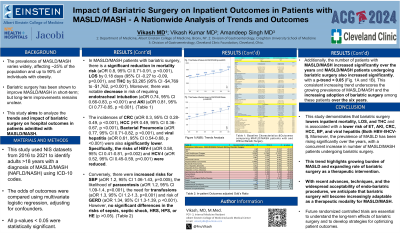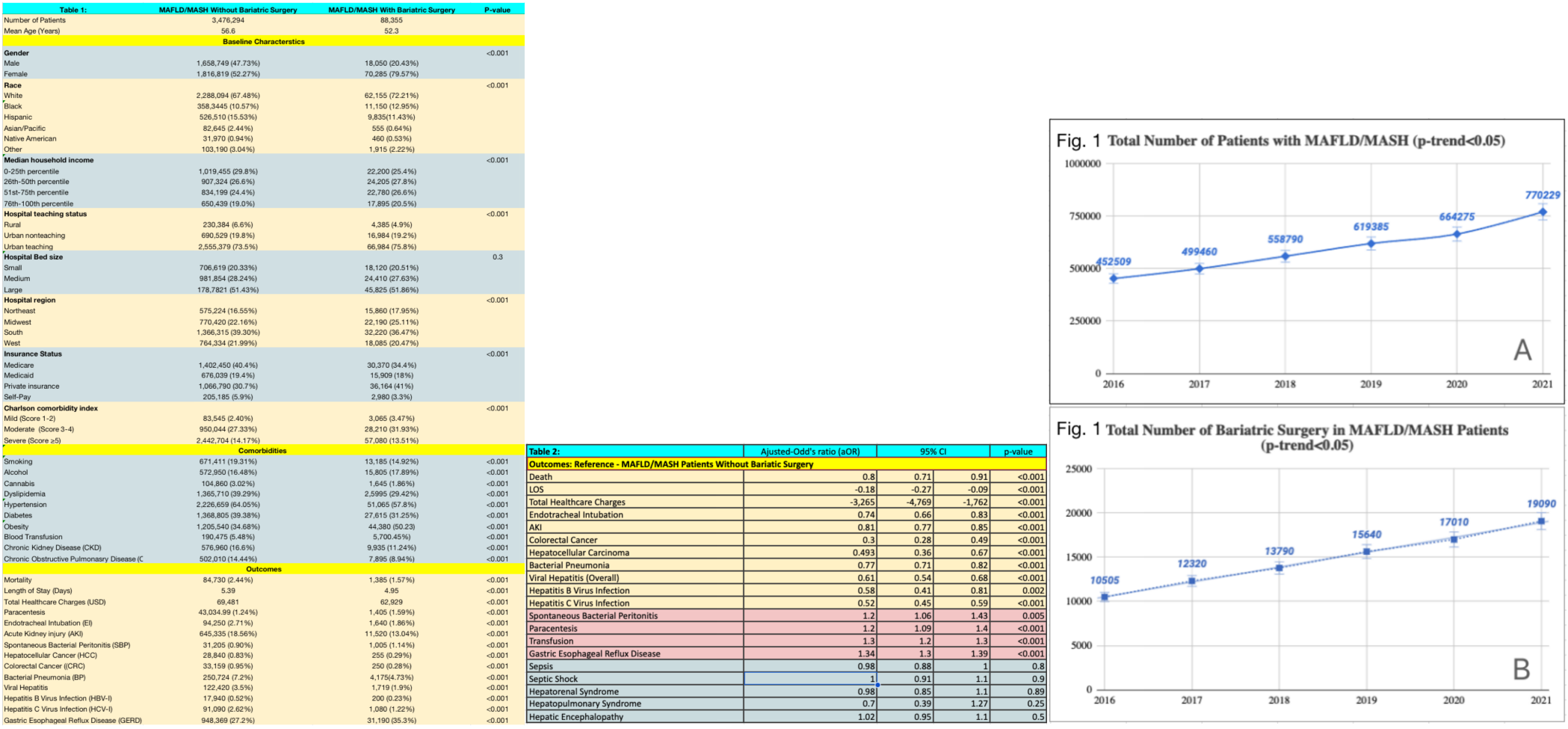Tuesday Poster Session
Category: Interventional Endoscopy
P4469 - Impact of Bariatric Surgery on Inpatient Outcomes in MASLD Patients: Trends and Analysis from a Nationwide Study (2016-2021)
Tuesday, October 29, 2024
10:30 AM - 4:00 PM ET
Location: Exhibit Hall E

Has Audio

Fnu Vikash, MD, M.Med
Albert Einstein College of Medicine
New York, NY
Presenting Author(s)
Fnu Vikash, MD, M.Med1, Vikash Kumar, MD2, Siddharth Pravin. Agrawal, MD3, Amandeep Singh, MD4
1Albert Einstein College of Medicine, New York, NY; 2Creighton University School of Medicine, Brooklyn, NY; 3Landmark Medical Center, New York, NY; 4Cleveland Clinic Akron General, Akron, OH
Introduction: The prevalence of MASLD varies widely, affecting ~25% of the population and up to 90% of individuals with obesity. Bariatric surgery has been shown to improve MASLD in the short term, but long-term improvements remain unclear. This study aims to analyze the trends and impact of bariatric surgery on hospital outcomes in patients admitted with MASLD.
Methods: This study used NIS datasets from 2016 to 2021 to identify adults >18 years old with a diagnosis of MASLD using ICD-10 codes. The odds of outcomes were compared using multivariate logistic regression, adjusting for confounders.
Results: In MASLD patients with bariatric surgery, there was a significant reduction in mortality risk (aOR 0.8, 95% CI 0.71-0.91, p < 0.001), LOS by 0.18 days (95% CI -0.27 to -0.09, p < 0.001), and total healthcare costs (THC) by $3,265 (95% CI -$4,769 to -$1,762, p < 0.001). Moreover, there was a notable decrease in the risk of requiring endotracheal intubation (aOR 0.74, 95% CI 0.66-0.83, p < 0.001) and AKI (aOR 0.81, 95% CI 0.77-0.85, p < 0.001). The incidences of CRC (aOR 0.3, 95% CI 0.28-0.49, p < 0.001), HCC (HR 0.49, 95% CI 0.36-0.67, p < 0.001), BP (aOR 0.77, 95% CI 0.71-0.82, p < 0.001), and viral hepatitis (aOR 0.61, 95% CI 0.54-0.68, p < 0.001) were also significantly lower. Specifically, the risks of HBV-I (aOR 0.58, 95% CI 0.41-0.81, p=0.002) and HCV-I (aOR 0.52, 95% CI 0.45-0.59, p< 0.001) were reduced.
Additionally, the number of patients with MASLD and MASLD patients undergoing bariatric surgery increased significantly, with a p-trend < 0.05 (Fig. 1A and 1B). This consistently increasing trend underscores the growing prevalence of MASLD and the increasing adoption of bariatric surgery among these patients over the last six years.
Discussion: This study demonstrates that bariatric surgery lowers inpatient mortality, LOS, and THC and is associated with a lower risk of ET, AKI, CRC, HCC, BP, and viral hepatitis (Both HBV-I/HCV-I). Moreover, the prevalence of MASLD has been rising significantly over the years, with a concurrent increase in the number of MASLD patients undergoing bariatric surgery. This trend highlights the growing burden of MASLD and the expanding role of bariatric surgery as a therapeutic intervention. With recent advances, techniques, and the widespread acceptability of endo-bariatric procedures, we anticipate that bariatric surgery will become increasingly adaptable as a therapeutic modality for MASLD.

Disclosures:
Fnu Vikash, MD, M.Med1, Vikash Kumar, MD2, Siddharth Pravin. Agrawal, MD3, Amandeep Singh, MD4. P4469 - Impact of Bariatric Surgery on Inpatient Outcomes in MASLD Patients: Trends and Analysis from a Nationwide Study (2016-2021), ACG 2024 Annual Scientific Meeting Abstracts. Philadelphia, PA: American College of Gastroenterology.
1Albert Einstein College of Medicine, New York, NY; 2Creighton University School of Medicine, Brooklyn, NY; 3Landmark Medical Center, New York, NY; 4Cleveland Clinic Akron General, Akron, OH
Introduction: The prevalence of MASLD varies widely, affecting ~25% of the population and up to 90% of individuals with obesity. Bariatric surgery has been shown to improve MASLD in the short term, but long-term improvements remain unclear. This study aims to analyze the trends and impact of bariatric surgery on hospital outcomes in patients admitted with MASLD.
Methods: This study used NIS datasets from 2016 to 2021 to identify adults >18 years old with a diagnosis of MASLD using ICD-10 codes. The odds of outcomes were compared using multivariate logistic regression, adjusting for confounders.
Results: In MASLD patients with bariatric surgery, there was a significant reduction in mortality risk (aOR 0.8, 95% CI 0.71-0.91, p < 0.001), LOS by 0.18 days (95% CI -0.27 to -0.09, p < 0.001), and total healthcare costs (THC) by $3,265 (95% CI -$4,769 to -$1,762, p < 0.001). Moreover, there was a notable decrease in the risk of requiring endotracheal intubation (aOR 0.74, 95% CI 0.66-0.83, p < 0.001) and AKI (aOR 0.81, 95% CI 0.77-0.85, p < 0.001). The incidences of CRC (aOR 0.3, 95% CI 0.28-0.49, p < 0.001), HCC (HR 0.49, 95% CI 0.36-0.67, p < 0.001), BP (aOR 0.77, 95% CI 0.71-0.82, p < 0.001), and viral hepatitis (aOR 0.61, 95% CI 0.54-0.68, p < 0.001) were also significantly lower. Specifically, the risks of HBV-I (aOR 0.58, 95% CI 0.41-0.81, p=0.002) and HCV-I (aOR 0.52, 95% CI 0.45-0.59, p< 0.001) were reduced.
Additionally, the number of patients with MASLD and MASLD patients undergoing bariatric surgery increased significantly, with a p-trend < 0.05 (Fig. 1A and 1B). This consistently increasing trend underscores the growing prevalence of MASLD and the increasing adoption of bariatric surgery among these patients over the last six years.
Discussion: This study demonstrates that bariatric surgery lowers inpatient mortality, LOS, and THC and is associated with a lower risk of ET, AKI, CRC, HCC, BP, and viral hepatitis (Both HBV-I/HCV-I). Moreover, the prevalence of MASLD has been rising significantly over the years, with a concurrent increase in the number of MASLD patients undergoing bariatric surgery. This trend highlights the growing burden of MASLD and the expanding role of bariatric surgery as a therapeutic intervention. With recent advances, techniques, and the widespread acceptability of endo-bariatric procedures, we anticipate that bariatric surgery will become increasingly adaptable as a therapeutic modality for MASLD.

Figure: Table 1: Baseline characteristics
Table 2: In-patient outcomes adjusted Odd’s ratio
Fig. 1 (A &B): Trends analysis
Table 2: In-patient outcomes adjusted Odd’s ratio
Fig. 1 (A &B): Trends analysis
Disclosures:
Fnu Vikash indicated no relevant financial relationships.
Vikash Kumar indicated no relevant financial relationships.
Siddharth Agrawal indicated no relevant financial relationships.
Amandeep Singh indicated no relevant financial relationships.
Fnu Vikash, MD, M.Med1, Vikash Kumar, MD2, Siddharth Pravin. Agrawal, MD3, Amandeep Singh, MD4. P4469 - Impact of Bariatric Surgery on Inpatient Outcomes in MASLD Patients: Trends and Analysis from a Nationwide Study (2016-2021), ACG 2024 Annual Scientific Meeting Abstracts. Philadelphia, PA: American College of Gastroenterology.
